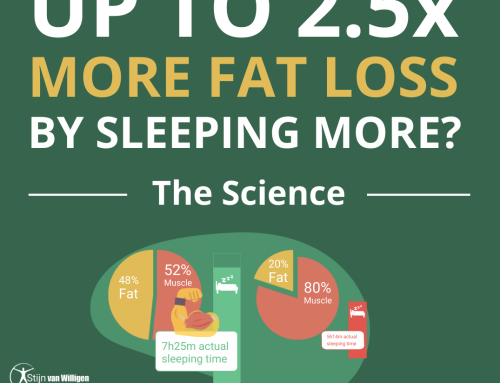1. Garthe et al. (2011) Effect of two different weight-loss rates on body composition and strength and power-related performance in elite athletes
- Although this is – to my knowledge – only 1 out of the 3 well-conducted studies that looked at non-overweight individuals, there is a basis of evidence to make recommendations (see the post).
- All participants continued their sport-specific training schedule (average 14.6 hrs per week), including 4 strength training sessions per week.
- The males had 16-17% bodyfat, the females 27-30%.
- They worked each muscle group twice per week with 2 exercises per session.
- The slow weight loss, higher calorie group probably stored more glycogen (and water) in their muscles, which could’ve boosted their muscle mass in the final DEXA scans.
- However: on the Press (+7.5 kg 1 rep max vs. +2.3) and Bench Pull (+5.8 kg vs +1.8) they got quite a lot stronger than the other group, which is an indicator of muscle growth.
2. Turicchi et al. (2019) Associations between the rate, amount, and composition of weight loss as predictors of spontaneous weight regain in adults achieving clinically significant weight loss: A systematic review and meta‐regression
- This meta-analysis included 43 studies with 52 different weight loss groups.
- Almost all groups had obese participants (BMI > 30 at the start), which is about 30-35% body fat (male perspective), which they reduced to 22-25% body fat throughout the study.
- Note that participants did not weight train in most, if not all studies
- Conclusion authors: there is no significant relationship between how fast you drop weight and sparing muscle mass.
3. Larky et al. (2020) Effects of gradual weight loss vs rapid weight loss on body composition and resting metabolic rate: A systematic review and meta-analysis
- While the previous meta-analysis of Turicchi (2019) pooled together the results of many studies, this meta-analysis only included studies that specifically compared 2 groups: one losing weight rapidly, and one losing weight gradually.
- End results: 7 studies included, excluding studies with “leaner” subjects (<30 BMI)
- 6 (!) of the 7 studies did not equate protein intake for the 2 groups, meaning a fast and very low calorie diet (of 600 kcal per day) with 50 g of protein could be compared to a gradual and moderate calorie diet of 1200 kcal per day with 90 g of protein, such as Vink et al. (2016).
- As expected: the quick, low protein groups in general lost more muscle mass.
- Only in Purcell et al. (2014) showed different results. Let’s look at it in detail…
4. Purcell et al. (2014) The effect of rate of weight loss on long-term weight management: a randomised controlled trial
- Published in reputable Lancet Diabetes Endocrinol. journal.
- 200 participants included, 75% women, BMI averaged 35.3 at the start (around 33% bodyfat for a male)
- 2 Groups: rapid weight loss (12 weeks dieting) and slow weight loss (36 weeks dieting).
- They measured muscle / fat mass with Bioelectrical Impedance Analysis (BIA) under standardized conditions.
- Protein intake was equated for both groups: an estimated 60-80g per day, therefore different from the other 6 studies included in the Larky et al. (2020) meta-analysis.
- Both groups lost around 15% body weight in total, so they went down to around 20% bodyfat (male perspective), although the Rapid group did it in 1/3rd the time.
- Note: Both weight loss groups drank Optifast protein products: one of the authors was Chair of the Optifast Medical Advisory Committee for Nestlé – mixed interests?
Strength of evidence explanation:





Leave A Comment